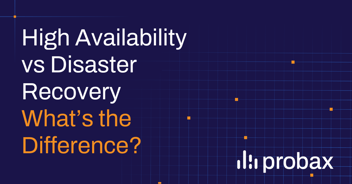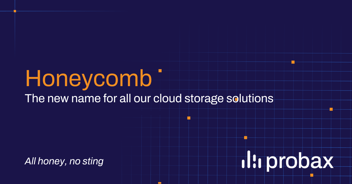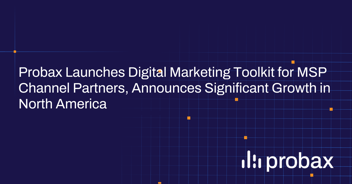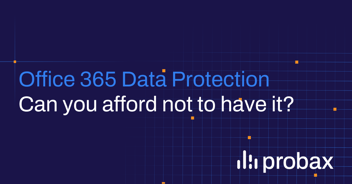Understanding the differences between Backup-as-a-Service (BaaS) and Disaster-Recovery-as-a-Service (DRaaS) is essential for a business that wants to minimize IT downtime.
Both terms refer to how your data is protected and how ready your company is for a disaster. In this piece, we’ll teach you about each term and describe some of the major differences between the two.
Here's everything you need to know to decide which option is right for your business.
What is BaaS?
BaaS stands for Backup as a Service. While conventional data backup methods are centralized and often performed on-premise, BaaS offers an alternate approach. Companies using BaaS purchase backup services from a third-party provider who then manages that data in their cloud - ensuring data is accessible and restorable in case of an outage or failure.
BaaS is far easier to manage than other offsite services. Instead of worrying about rotating and managing tapes or hard disks at an offsite location, IT managers can offload maintenance and management to a provider. BaaS providers go to great lengths to comply with safety regulations and protect their customers’ data. They usually keep multiple copies of your backup data, run various testing procedures and generate reports to ensure that their clients can access and restore their data when needed.
Typically, backups should follow the 3-2-1 rule (or 3-2-1-1-0 rule), meaning you should have 3 separate backup copies of your data, these copies should be stored in two different forms of media, and one of these copies should be stored offsite (in the cloud).
What is DRaaS?
DRaaS is Disaster Recovery as a Service. “Disaster Recovery” or "DR" is a term that refers to your company’s ability to bounce back after a natural disaster, human error, cyberattack, or some other event that results in an outage or total system failure.
As its name suggests, DRaaS is a SaaS based Disaster Recovery offering. DRaaS provides an off-site DR capability that lets customers avoid the cost of maintaining secondary data centres. The approach has opened DR to organizations that wouldn't have been able to afford such a capability in the past.
DRaaS works by replicating and hosting servers in a third-party vendor’s cloud. In the event of a natural disaster, system failure, or other disaster that affects business continuity, an organization can quickly regain access and functionality to their IT infrastructure by failing over to the DRaaS provider's cloud. This means recovery time after a disaster can be much faster (or even instantaneous) when compared to relying on just BaaS alone.
The Differences Between BaaS and DRaaS
There are some major differences between BaaS and DRaaS - and they become apparent when you have to recover after a total system failure. This section will explain the two major differences.
Speed of Recovery
IT downtime can have catastrophic consequences on a business. Costs associated with downtime accumulate from loss of revenue, lost employee productivity, damage to your reputation and more.
Needless to say, you want to minimize the amount of downtime and data loss that your business experiences during an outage or disaster. Two important parameters that define a disaster recovery plan are the Recovery Point Objective (RPO) and Recovery Time Objective (RTO).
- RPO limits how far to roll back in time, and defines the maximum allowable amount of lost data measured in time from a failure occurrence to the last valid backup.
- RTO is related to downtime and represents how long it takes to restore from the incident until normal operations are available to users.
In simple terms, RPO is about how much data you afford to lose before it impacts business operations, and RTO is the timeframe within which applications and systems must be restored after an outage.
Despite the data restoration capabilities of BaaS, organizations will experience far longer waiting periods between outages and normal infrastructure operation This means that your RPO and RTO will be slower, measured in hours or even days. With DRaaS, you can recover much quicker, with RPO measured in seconds and RTO in minutes. This means you can get your business back up and running faster in any worst-case scenario.
Cost (“Time is money”)
Since DRaaS is focused on the rapid recovery of data and applications, it is usually a more expensive option than BaaS. However, it's important to bear in mind that these costs are a mere fraction of the total costs associated with downtime - which typically lie in the range of $137 to $427 per minute for small businesses, according to consulting firm IDC. If you'd like some help quantifying the impact of downtime on your business, take a look at our simple downtime calculator.
BaaS is the perfect low-cost solution for small companies where some data loss or downtime is acceptable. But remember, the longer the downtime, the greater the impact - so deciding to only use BaaS may cost your business more in the long run.
If an organization has sufficient budget, and the cost of downtime (either financially or non-financially) outweighs the investment cost, DRaaS quickly becomes the obvious choice.
DRaaS Solutions Vary (Significantly)
The idea that all DRaaS solutions are the same is a common misconception. The truth is, picking the wrong solution and/or provider might be the difference between bouncing back and closing up shop after a disaster. It’s okay to ask questions to a potential DRaaS provider before moving forward. If they don’t offer the best protection for your business, chances are it’s not worth it.
So how are they different? Well, some providers offer backup-based DRaaS solutions, meaning they recover your environment in the cloud using backup images - this will obviously take considerably longer to spin up compared to a true DRaaS solution that continuously replicates your environment to a provider’s cloud.
The other key difference relates to the RPO/RTO parameters mentioned above. Most DRaaS providers are focusing on RPO/RTO of failover only - and neglecting failback altogether. This usually leads to clients needing to manually restore data and services to bring back their production sites after a rebuild - consequentially losing significant amounts of time and revenue. Needless to say, make sure your provider offers quick and seamless failover and failback.
And remember, if you're not sure what your vendor's failover/failback technology and process is, ask! A reliable provider offers DRaaS with a goal to make both failover and failback frictionless by leveraging market leading technology like Veeam.
Picking the Right Provider
If you want reliable BaaS and DRaaS solutions that tick all the boxes, you need to find a reputable provider. At Probax, we specialize in offering market-leading BaaS and DRaaS options that minimize your downtime, maximize what’s protected, and optimize the speed of recovery.
We’ll help you create and maintain an effective backup and disaster recovery strategy - and we can even manage it for you with our Managed Data Protection Service. If you are interested in learning more, or if you have any questions on how to elevate your data protection strategy, why not schedule a brief meeting with one of our data protection specialists HERE. We'd love to hear from you!
Want more information about why DRaaS is so effective? Click below to download our ebook.






